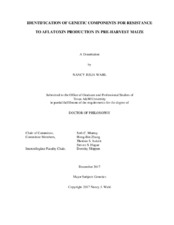| dc.description.abstract | Aflatoxins, produced by the fungus Aspergillus flavus, often contaminate preharvest maize (Zea mays L.) grain under heat and drought stresses, and pose serious health hazards to humans and livestock.
Since 2003, a multi-environmental trial of public breeding maize (Zea mays L.) hybrids across multiple programs in the southeastern United States has evaluated accumulation of aflatoxin following inoculation with the fungus, A. flavus. The Southeast Regional Aflatoxin Trial (SERAT) was formed to identify public germplasm with the most consistent resistance to aflatoxin accumulation and agronomic traits in different environments. Yield and agronomic traits were evaluated in 13 locations, aflatoxin in four, from 2006 to 2015. The 295 experimental hybrids that included tropical and subtropical derived germplasm exhibited lower average levels of aflatoxin and lower average yield versus commercial checks. However, the 13 top-performing experimental hybrids identified in SERAT yielded as much or exceeded check averages, and had aflatoxin levels significantly lower than check averages.
A second study was conducted to investigate changes in differential gene expression (DGE) during seed morphogenesis and maturation in the "aflatoxin resistant" inbred line TX772 when challenged by A. flavus through two different methods of ear inoculation; non-wounding (silk channel) and wounding (side needle) in reference to a non-inoculated control. Grain maturity had the largest effect on RNA-Seq DGE, however, within each stage of development, similar up-regulation in expression from either inoculation method was observed. A larger number of fungal reads were observed in side-needle inoculated samples and a correlation of .65 between fungal read percentages and aflatoxin were found. Sixteen genes previously associated with resistance to pathogens were identified among the transcripts differentially expressed (DE) at p ≤ .05, FDR ≤ .10, and fold change ≥ 2.0 over all stages. Others not directly associated with resistance but differentially expressed included six zeins, and eight enzymes controlling carbohydrate metabolism. This study confirmed previously implicated candidate genes for resistance and identified new pathways to control A. flavus by investigating a unique maize genetic background.
Together these two studies provide new insights into germplasm and genes to further reduce aflatoxin in a field environment. | en |


